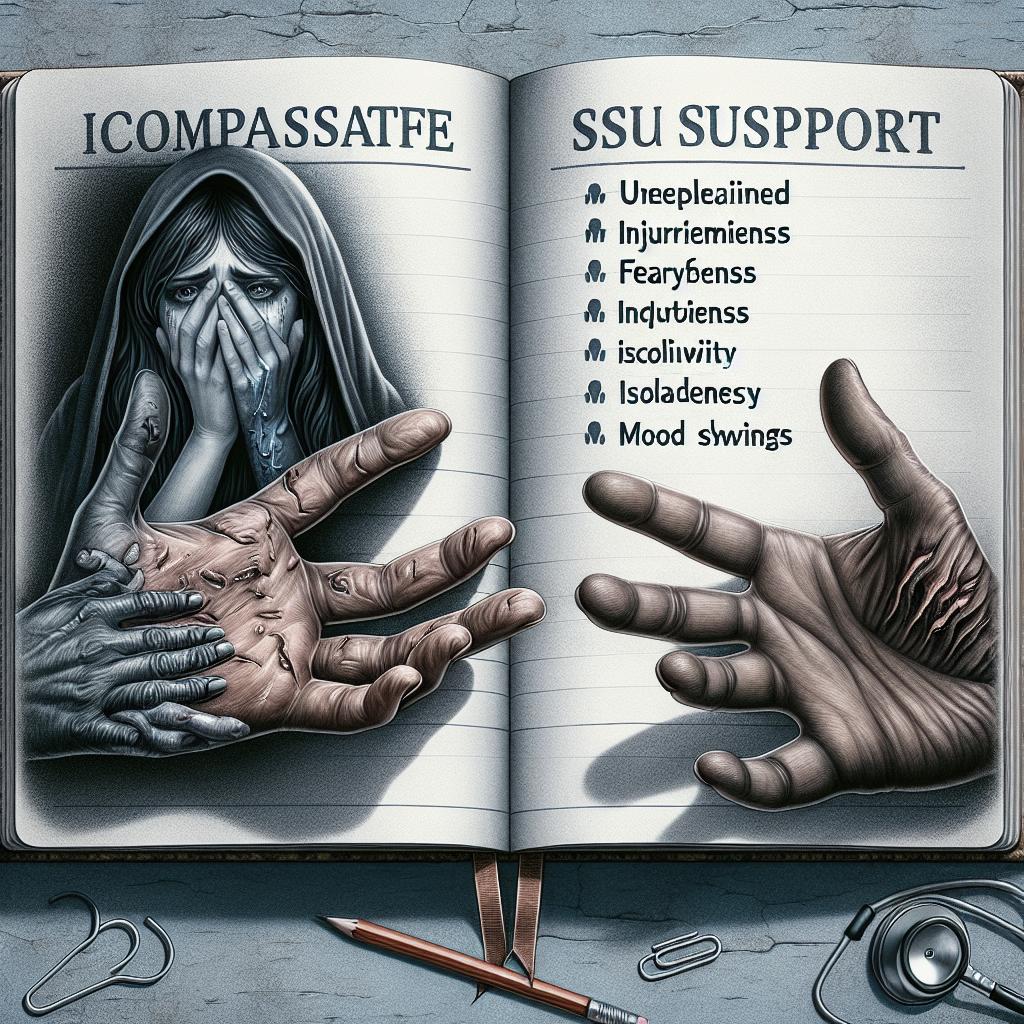“`html
Recognizing Signs of Abuse: A Comprehensive Guide
Abuse is a serious issue that affects individuals across all demographics. It can manifest in various forms, including physical and emotional abuse, and often leads to significant behavioral changes in victims. Understanding these signs can be instrumental in providing help and support to those affected. This blog post explores the physical and emotional indicators of abuse, delves into how abuse transforms behavior, and outlines controlling behaviors displayed by abusers. Additionally, we provide guidance on how to assist loved ones potentially suffering from abuse, hoping to foster awareness and empower individuals to take action.
Physical Signs of Domestic Abuse
Physical signs of domestic abuse can be the most visible indicators. Victims may have unexplained injuries such as bruises, cuts, or burns, often with inconsistent explanations about how they were sustained. These marks may be frequent or appear in stages of healing, suggesting continuous harm over time.
In some cases, the abuser may physically confine the victim, leading to malnutrition or visible signs of stress and exhaustion, such as weight loss or insomnia. Changes in how the victim dresses can also be a sign, such as wearing long sleeves or sunglasses indoors to cover injuries.
Frequent visits to health professionals with recurring injuries can be significant red flags. Medical personnel are trained to spot these patterns, but friends and family should also remain vigilant and encouraging for the victims to seek help.
Emotional Signs of Domestic Abuse
Emotional abuse can often be more harmful than physical violence due to its insidious nature. Victims may show signs of depression, anxiety, or loss of self-esteem. They may withdraw from social activities they once enjoyed and isolate themselves from friends and family.
Another emotional indicator is difficulty concentrating or making decisions, often stemming from constant belittling and control by the abuser. Victims may also express hopelessness or fearfulness, impacting their personal and professional lives.
Victims might frequently apologize or seem overly eager to please their partners, stemming from a fear of triggering their abuser’s anger. This behavior may manifest in public settings, but is often more visible in private interactions.
How Abuse Causes Behavior Changes
Persistent abuse leads to significant behavioral changes in victims. They may develop a sense of learned helplessness, where they feel powerless to change their situation, often resigning themselves to their predicament.
Over time, some victims may adopt hyper-vigilant behavior, always on edge, fearing their abuser’s actions. They may seem jumpy or startled by noises, signs of an underlying constant state of stress.
Showing Signs of Fear
A victim’s demeanor can shift to one defined by fear. They might constantly seek their partner’s approval, avoiding actions that could provoke anger. Fear can manifest as hesitation in speaking or making simple decisions, reflecting the authoritarian control the abuser exerts.
These signs can make it challenging for victims to leave abusive relationships as they become reliant on their abuser both emotionally and financially, entangled in a cycle of violence and manipulation.
What Controlling Behavior Looks Like
Abusers employ diverse methods to exert control over their victims. This can include dictating whom the victim can see and interact with, restricting access to financial resources, or monitoring digital communications and social media activity.
Isolation is a significant tactic used to maintain power, ensuring that the victim remains dependent and unable to seek support externally. Additionally, abusers might use intimidation tactics such as threats against the victim or their loved ones, further trapping the victim in fear.
Gaslighting is a common strategy, where the abuser causes the victim to doubt their own perceptions, memory, or sanity, eroding their confidence and control over their own life.
How to Help a Loved One
Supporting a loved one who might be experiencing abuse begins with belief and compassion. Be an attentive listener and create a safe space for them to express their concerns without judgment or pressure.
Encourage them to seek professional help or counseling, and if they feel comfortable, assist them in contacting support networks like domestic violence hotlines or shelters. However, remember that the decision to leave an abuser must come from them.
It’s crucial to understand that not all victims are ready to take immediate steps; patience is key, and your continued support can be the foundation they need to make an empowered decision.
Takeaways
The path to recognizing and addressing abuse is fraught with challenges, but informed awareness paves the way for meaningful support and intervention. Recognizing physical and emotional signs, understanding behavioral changes, identifying controlling behaviors, and knowing how to help are essential elements of providing aid to victims.
Our collective responsibility lies in being vigilant, empathetic, and proactive. By fostering open dialogue and support networks, we can combat the stigma surrounding abuse and aid in the recovery and empowerment of victims.
Below is a summary of key points covering the discussed topics:
| Aspect | Summary |
|---|---|
| Physical Signs | Unexplained injuries, frequent medical visits, changes in appearance. |
| Emotional Signs | Depression, anxiety, isolation, loss of self-esteem. |
| Behavioral Changes | Learned helplessness, hyper-vigilance, fear-driven actions. |
| Controlling Behavior | Isolation, intimidation, financial control, gaslighting. |
| Ways to Help | Listen, support, encourage professional help, respect their decisions. |
“`


